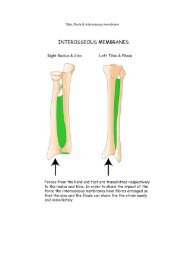GSM 11.14 - Version 5.2.0 - Digital cellular ... - Ttfn.net
GSM 11.14 - Version 5.2.0 - Digital cellular ... - Ttfn.net
GSM 11.14 - Version 5.2.0 - Digital cellular ... - Ttfn.net
Create successful ePaper yourself
Turn your PDF publications into a flip-book with our unique Google optimized e-Paper software.
Page 24<br />
<strong>GSM</strong> <strong>11.14</strong> version <strong>5.2.0</strong>: December 1996<br />
6.5.3 Alpha identifier in response data<br />
Many of the commands include an alpha identifier data object. This is intended to be a short one or two<br />
word identifier for the ME to optionally display on screen along with any other indications, at the same time<br />
as the ME performs the SIM command. If longer text statements are required, which must be displayed on<br />
the screen, the SIM shall send a separate display command.<br />
6.6 Structure of proactive SIM commands<br />
BER-TLV data<br />
object<br />
SIMPLE-TLV<br />
data object<br />
Elements within<br />
the data object<br />
T L V 1..n SIMPLE-TLV objects<br />
T L V 1..m elements T L V<br />
Proactive SIM commands are sent across the interface as BER-TLV data objects. The tag is a constant<br />
value, length one byte, indicating it is a proactive SIM command.<br />
The length is coded onto 1,or 2 bytes according to ISO 7816-6. The following table details this coding:<br />
Length Byte 1 Byte 2<br />
0-127 length ("00" to "7F") not present<br />
128-255 "81" length ("80" to "FF")<br />
Any length within the APDU limits (up to 255 bytes) can thus be encoded on two bytes. This coding is<br />
chosen to remain compatible with ISO/IEC 7816-6 [17].<br />
Any values for byte 1 or byte 2 that are not shown above shall be treated as an error and the whole<br />
message shall be rejected.<br />
The value part of the BER-TLV data object consists of SIMPLE-TLV data objects, as shown in the<br />
sections below on individual commands. It is mandatory for SIMPLE-TLV data objects to be provided in<br />
the order given in this section for each command, but they do not necessarily need to be consecutive.<br />
(i.e., in the future, new SIMPLE-TLV data objects can be added to the middle of a command). The coding<br />
of SIMPLE-TLV data objects are specified later in this document.<br />
The M/O columns specifie whether it is mandatory or optional for the sender to send that particular<br />
SIMPLE-TLV data object for compliance with the current version of this TS. The Min (Minimum Set) column<br />
describes whether it is necessary for the receiver to have received that particular SIMPLE-TLV data object<br />
to be able to attempt at least the most basic form of this command. The procedure for dealing with<br />
incomplete messages is described in section 6.9.<br />
"00" and "FF" are never used as tag values for BER-TLVs. Before, between or after BER-TLV data<br />
objects, "00" and "FF" bytes without any meaning may occur (i.e. padding characters). This is in<br />
accordance with ISO/IEC 7816-6 [17]. The ME shall ignore them.<br />
See ISO/IEC 7816-6 [17] for more information on data objects.








